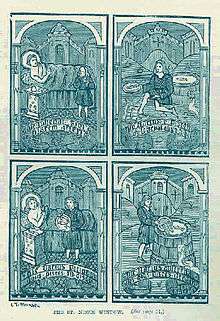Neot
| Saint Neot | |
|---|---|
 A stained glass window at Eynesbury, Cambridgeshire, illustrating the life of St Neot | |
| Hermit | |
| Died | 9th Century |
| Venerated in |
Catholic Church Western Orthodoxy |
| Major shrine |
St Neot, Cornwall (original) St Neots Priory (destroyed) |
| Feast | 31 July |
| Patronage | Fish |
Neot is a saint of the ninth century who lived as a monk and hermit in Cornwall. He is mentioned in an interpolated passage in Asser's Life of King Alfred[1] and died around AD 870. He is venerated as a saint in the Roman Catholic and Western Orthodoxy. His legend is preserved in two Latin "lives" and one Old English "life," dating from the eleventh and twelfth centuries, with other mentions preserved in later chronicles.
Life
Neot, who is said to have stood four feet tall,[2] seems to have begun his adult life as a soldier, later renouncing a martial lifestyle for life in a monastery.[3] He served as sacristan at Glastonbury Abbey but later lived in Cornwall, at first alone, then with a growing group of other monks near Bodmin Moor. He was remembered because of his good work in caring for the poor.
Tradition states that King Alfred visited him for his counsel and it is in a book about St Neot that we read about King Alfred burning the cakes when hiding from the Danes at Athelney.[3]
Two of the fifteen stained glass windows in the church of St Neot, Cornwall portray the saint: one of them consists of scenes from the life of the saint.
Relics of St Neot
His bones were preserved as a holy relic in the Cornish village of St Neot. St Neot's body was removed from Cornwall to Eynesbury in Huntingdonshire in around 980 when a monastery was founded there (renamed St Neots Priory in his honour).[4] The monks returned with their prize, pursued (according to some versions) by angry Cornishmen. The bones were housed in the priory for many years but were finally 'lost' during the reign of Henry VIII during the Dissolution of the Monasteries. His feast day is 31 July (celebrated at St Neot on the last Sunday of July).[1] He is also the patron saint of fish.[5]

Legacy
The Cornish village of St Neot and the Cambridgeshire town of St Neots are named after him. There are many churches dedicated to St Neot and at least one Holy Well.[3] Legend has it that the well contained three fish, and an angel told St Neot that as long as he ate no more than one fish a day, their number would never decrease. At a time St Neot fell ill, and his servant went and cooked two of the fish; upon finding this, St Neot prayed for forgiveness and ordered that the fish be returned to the well. As they entered the water, both were miraculously returned to life.[6]
There is a commemorative mosaic of the saint in the Market Square in St Neots. The mosaic is based on a Saxon ornament, the Alfred Jewel.
Notes
- 1 2 Cornish Church Guide (1925) Truro: Blackford; p. 170
- ↑ "St. Neot", Cornwall Tour
- 1 2 3 "Who was St Neot?", St Neots in Cambridgeshire
- ↑ "St. Neot and King Alfred", St. Neot Parish Website
- ↑ Patron Saints Index, Accessed 11 Nov 2010, http://saints.sqpn.com/patrons-of-fish/
- ↑ Thompson, E. V. (1984). 100 Years on Bodmin Moor. St Teath: Bossiney Books. ISBN 0-906456-90-8.
References
- The Anglo-Saxon Chroncile: A Collaborative Edition, vol. 17: The Annals of St Neots with Vita Primi Sancti Neoti, ed. David Dumville and Michael Lapidge. Cambridge: D. S. Brewer, 1985.
- Mary P. Richards, "The Medieval Hagiography of St. Neot," Analecta Bollandiana 99:3-4 (1981), pp. 259–278. https://doi.org/10.1484/J.ABOL.4.03043
- Young, Rosa (1996) St Neots Past, pp. 15–18. Chichester: Phillimore and Co Ltd. ISBN 1-86077-025-8
- BHL 6052 (1101–1125) : Vita (AASS 31 Jul.)